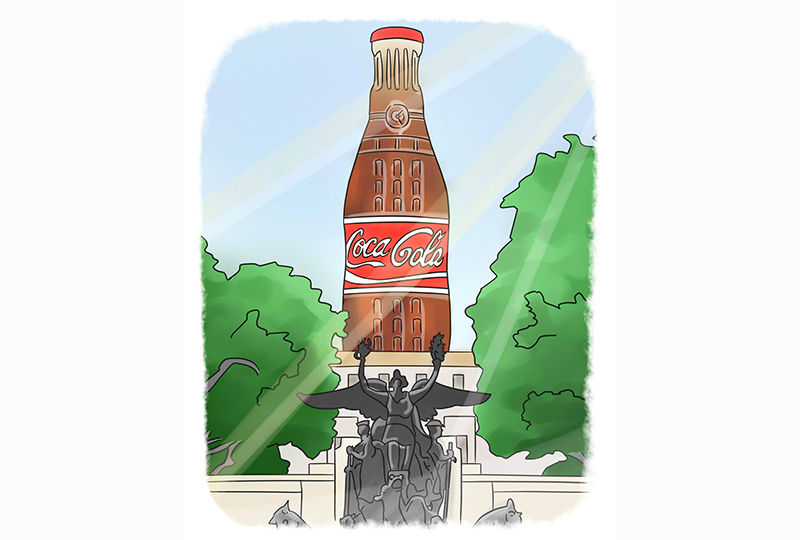This month, the University of California at San Francisco stopped selling sodas and other sugary beverages on campus. This move might be drastic to some, but it is a clear administrative choice about prioritizing student health over business benefits.
Many universities hold sales agreements with soda producers, which contributes to high rates of soda consumption in university students. A 2006 study found that 95 percent of undergraduates in an urban southern campus reported consuming at least one sugary beverage in the past month, and a 2008 study found that 39 percent undergraduates at a large public university had consumed at least one energy drink in the past month. These high consumption rates are startling because soda consumption contributes to diabetes, cardiovascular diseases and certain cancers, and potentially contributed to 184,000 deaths per year, according to health science journal Circulation.
According to the Division of Housing and Food Service, the retail dining operations sold 973,690 total pre-packaged or bottled beverages since last year. Of this number, over 34 percent — or more than 331,054 — were soda, sports and energy drinks. In addition to that, over 100,000 fountain drinks were sold — which can include soda, tea, lemonade, Powerade, flavored water and more.
This issue is particularly prevalent during stressful times of the academic semester, such as finals and midterms. Students usually use these beverages to stay alert during long study sessions. However, what students do not realize is the sugar and caffeine rush and steady intake of high fructose, which is contained in soft drinks, slows the brain, hampering memory and learning abilities, according to a UCLA study.
Universities are not the only teaching institutions to provide a platform for unhealthy habits of consuming sugary drinks and the accompanying health and academic problems. Sales agreements between big soda beverage companies and schools make it easier for students to purchase such beverages. In 2005, nearly half of all public elementary schools and about 80 percent of public high schools had contracts with Coca-Cola or Pepsi.
Some might argue that sugar-added beverages may not be the cause of chronic diseases, since factors such as individual’s weight, age, race/ethnicity, physical activities and socioeconomic issues also contribute to one’s well-being. According to Lindsay Wilson, a registered dietitian on DHFS staff, health issues may correlate to the consumption of sugary beverages but may not be the cause of them.
“The studies out there haven’t been able to specifically pinpoint sugar-sweetened beverages as the cause for any health-related conditions,” Wilson said. “That’s not saying that they are not a potential contributor to some of those conditions, but they can be included as a healthier diet. It’s about how much and how frequently you consume it.”
In line with this train of thought, it would be unfair for institutions to restrict consumer choices based on an incomplete understanding of how sodas affect health.
“We are not telling [our students] they can’t [drink soft drinks], but we are giving them other options they can refer to,” said Rene Rodriguez, the director of food service.
However, providing healthier alternatives to students’ beverage selection is really just giving students more choices, not less, and minimizing harm from unhealthy beverages. To promote alternative choices, DHFS keeps a registered dietitian on staff and offers nutritional courses in campus dining halls to educate students about what a healthy diet looks like. Additionally, DHFS plans to install at least two infused water stations this year, which will provide naturally fresh water with combinations of fruits and vegetables without any added sugar inside DHFS dining locations, according to Rodriguez. DHFS also installed 12 separate water stations next to their 12 fountain beverage stations to promote healthy dietary choices.
These education programs and healthier alternatives are a good start to lowering campus consumption of soda. But DHFS can still do more. According to Rodriguez, DHFS ranks the top drinks to determine who gets the best spot on their shelf. This strategy responds to student preference and makes sense from a business standpoint. But it is simply wrong to market sugary drinks on campus, given the widely known health risks. Bottled water should always be placed at the most obvious location on the shelf to promote healthy alternatives, and DHFS should place fountain drink dispensers in less prominent areas of dining halls. Banning soda outright may not be the answer, but promoting alternatives will be a first step in reducing sugary drinks consumption and associated health risks.
It is time for our school to look at priorities. In the end, a healthier environment is what a university should strive for.
Liu is an advertising graduate student from Beijing.





















